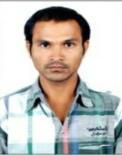COMPOSITE IMAGELET IDENTIFIER FOR ML PROCESSORS
Ajay Kumar Naik G1, Suresh Babu B2 , Srinivasan V3 Mohammed Aslam C4, Lakshmi Kiran M51Assistant Professor, Dept. of ECE, CBIT, Proddatur, Andhra Pradesh, India

2 Assistant Professor, Dept. of ECE, CBIT, Proddatur, Andhra Pradesh, India
3 Assistant Professor, Dept. of ECE, CBIT, Proddatur, Andhra Pradesh, India
4 Associate Professor, Dept. of ECE, CBIT, Proddatur, Andhra Pradesh, India
5 Associate Professor, Dept. of ECE, CBIT, Proddatur, Andhra Pradesh, India ***
Abstract - Image transformations have played a vital role in capturing relevant data from resizing, conversion, edging and pixilation strategies for better processing of explorable data fromthe image lets. They have beenusingextensivelythe approximation methods with finite differences used to manipulate Edges have weight representing energy in real time pictures captured by cameras with moderate and high resolutions. Deployment of such applications are found in forestry animal husbandry without spoiling the biome, detecting animal cruelty and enhancing safety of humans against uncontrolled fauna. AI machines of future are digital variants of panorama and aerial image processors.
Key Words: CNN, Computer Vision in Machine Learning, SSIM, FPGA, APR-AI-ML
1.INTRODUCTION
Graphics management tools like photoshop, fotoflexer, amazon image, in addition to PRISM APR have built-in addons intersecting aspect ratio of the image section that you want to designate with n same locations that need regeneration.SSIM[1]valuesaremetricsinsuchseamtools inmultimediabuttheyinvolvemanualinterventionbased onrequirement.EnergyEnhancementfunctionsareinvolved inIndustrytoolsetslikePegasusAPA,AItoolsandComputer Vision techniques like Tensor flow, Open CV, Keras deep learningetc.ascontentawareimagetargetingtofocuson theobserverfactionmainlybasedonDijkstra'salgorithm.In this paper a simulation of such pixilation and edge transformationisdoneonrealtimeimagestocomparetheir performanceonlightweightdevicesthatarequickerinseam processthanhighdensityimagecapturingdevices.
1.1 Conventional image processing methods
BeforeCNNareincorporatedtoassesswhetheranimage hasbeen modified byseam carving. Thoughthe proposed research is not an intelligent fake image detection and tamperingindigitalimages[1],bututilizingthemethodsto track image modifications with minimum motion pictures instead of videos that requires either GPUs or FPGA high density[3]chipstoprocesstheimagedatawithlimitations in storage and retrieval compared to magnetic tapes in traditionalbigdatastorage.
Thediagramshownbelowcontainspartialcomputations aspartofdynamicprogramminginfindinglowest-energy verticalseam,foreachpixelinarowsubmission.Shownin Fig1b)arethesimulationresultsfromMATLABrelease-20 with both inbuilt and user-defined functions utilized to computetheimageindicesfortheexperimentalimagelisted below.
1.2 Image manipulators
The basic processing begins with the image intensity matrixobtainedfromthepixelatedimage,fromwhichseam locations are defined and manipulated with the algorithm defined in the block diagram. Calculation of CME is for uncompressed image is the requirement of the stature identification algorithm that utilizes back-tracking procedureofminimumenergyalongtheseampath.Thepmap [1] quantization may introduce false positives as perceptivedistortionsintroducedorcaptured.Themethod todifferentiatebetweenthetwoisdiscussedinthepaper. Reduction of false positives by expectation-maximization probabilitytechniquesisoutofscopeoftheresearch.The segregationoftheindividualimagesfrombigdatarepository canbelaterimplementedforIQAwithminimaldegradation inimageconversionpreservingthecolorinformationand separationofidentifiedportionsofODasthefuturerelieson cloudstorageplatformsmainlyforAI-MLprocessors[5].
Anapproachtoinvestigatethestudyonmachinelearning of SEM images are helpful in magnifying the algorithmic modeltobeutilizedforthecomputervisionaryoflocation staturebyOIM-SEAMstudies[6].
2. SEM TRANSFORMATION APPLICATIONS
Image techniques are already in use in spectroscopy (EDS),forfractography,PCBtechnologytestingintermetallic distribution in solder interfaces, SSPM Seam scope projection AUTO-XTS machines for miniature material detectionpurposes.Theproposedsolutioncitedinpaperis based on mega structuresidentificationand manipulation utilizing the study on algorithms implemented for above existing applications. The proposed experiments are intermediate between existing material surveillance and distantsurveyorslikeSSTLS1-4leaseddevicesformission
criticalapplications.Theprocessingofobliqueandvertical resolutions as in GIS are beyond scope of the current experiment. Only JPEG and SVG images are utilized in the experiment.
Gradient magnitude, entropy, visual saliency, eye-gaze movementareMERLseamalgorithmsthatarecomparedin the below screens with the input image. Combinatorial optimization techniques like greedy algorithms with variations,implementedforaboveexistingapplications.The proposed experiments are intermediate between existing materialsurveillanceanddistantsurveyorslikeSSTLS1-4 leased devices for mission critical applications. The processingofobliqueandverticalresolutionsasinGISare beyondscopeofthecurrentexperiment.Thebasicalgorithm uses following main equations for manipulation of seam linesindicatedinequations1,2and3.
1. Seamequation

S = [min ∑ e(I(si)))]
Energyvector [i, j] = e [i, j] + min (M [i - 1, j], M [i, j], M [i + 1, j]);




2. Seam sn1 is defined for coordinates n1=1, 2…,Nas
sn1= {(n1, T (n1))} ∀n1|T (n1) −T (n1 1) |≤ 1
3. Accumulative cost matrixM (n1, n2) for all possibleseamconnections
M(n1,n2)=e(n1,n2)+min(M(n1 1,n2 1),M(n1 1, n2),M(n1 1,n2+1))
Image resizing with K-neighbor algorithm implementing salient regions with parts of the background of entire regionalspatialcontent,isunaccountableforspatiallosses comparingboundaryelementmethod.Shownbelowisthe seam technique with layers for resized image output. The decodingofimagestothequantizedvaluesisachieved by existingSobel–Feldmanmainlyusedforcomputervisionis discussed.Thoughthealgorithmisalreadyimplementedasa MATLABfunctionforplots,itsuseandfurtheradditionsmay enhance the seam detectors. The subsections of the algorithm involved in SEAM processing is analyzed by breaking them into program-sublets shown in Fig 1a. The processinginvolvesthegradientcomputationthatisutilized bydistributedgrabber,followedbysynthesizermayprepare the image with scaled metrics for windowing to facilitate seamindistributedcomputingsystems.Thus,themachine learning process may be fully complete with algorithmic induction of the devices computing the multiple-oblique seamsinaPCbasedpostprocessingsystemoranandroid appinfuture.
2.1 Abbreviations and Acronyms
BEM: Block Element Modifier generally used in stream textbutnewforimageswithCAPTCHA
SSIM: StructureSimilarityIndexMeasure
XTS: IEEE Advanced Encryption Standard

algorithmforextendedimageprocessors
FPGA:FieldProgrammableGateArrayhardwarechipsfor
multiprocessing
AI-ML: ArtificialIntelligenceandMachineLearning
forcommutervisionarydevices
CNN: ConvolutionalNeuralNetworkprocessors
3. CONCLUSIONS
Image SEM trainer-based tolls are readily available with multi-imageprocessingGUIsthatportdatafromminiature electronic devices. Such data use maximized filtering to reducesnoisesthatareintersectingvitalinformationwithin theboundaryconditionsdefined.Theseammanipulationisa different rea where the calculations based on seam need separatealgorithm.Thispaperhasexposedtheresearchon Seam utilization techniques for identifiers for vital eco system applications. The image analyzed and extracted in Figure 1c) clearly indicates the performance levels higher compared to moving video image processing with high densitydevices.Thisstudymaybehighlyusefultominimize thecompatibilityissuesofdevicesthatcanutilizeinternet storagefortheirfuturisticdatastudyacrosscloudplatforms.
ACKNOWLEDGEMENT
We like to acknowledge Principal, CBIT, Director of R&D, CBIT and staff members of CBIT for supporting us in technicalworksrelatedtoresearchinDIP.
REFERENCES
[1] A.Sarkar,L.Nataraj,B.S.Manjunath,“DetectionofSeam Carving and Localization of Seam Insertions in Digital Image”, Vision Research Laboratory University of California,SantaBarbara.
[2] L.F.SCieslak, K. A.Pontara da Costa,J. P. Papa,“Seam Carving Detection Using Convolutional Neural Networks”, IEEESACI-12,IEEEXplore:August2018.
[3] E.Mishra,S.Narayan,K.Lim,”FPGAAcceleratedSeam CarvingforVideo”,ProjectinElectricalandComputer Engineering,CarnegieMellonUniversity.

[4] A.Garg,A.Nayyar,A.K.Singh,“Improvedseamcarving for structure preservation using efficient energy function,” Multimedia Tools and Applications, vol. 4, April2022.
[5] J. Pope, M. Terwilliger, “Seam Carving for Image ClassificationPrivacy”,DepartmentofComputerScience andInformationSystems,UniversityofNorthAlabama, Florence,Alabama,U.S.A.
[6] P. Nguyen, R. Surya, M. Maschmann, P. Calyam, K. Palaniappan, F. Bunyak “self-supervised orientationguided deep network for segmentation of carbon nanotubes in SEM imagery”, European Conference on ComputerVision,February2023.
[7] IzumiIto,“Gradientbasedglobalfeaturesforseamcarving”, EURASIPJournalonImageandVideo,an.27,September2016
BIOGRAPHIES
Ajay Kumar Naik Guguloth is working as Assistant Professor withCBITandhas9yearsofwork experienceandhascompletedhis M.Tech in VLSI from NIT, Surathkal,India.


Suresh Babu Byri is working as AssistantProfessorwithCBITand has 12 years of work experience and pursuing Ph.D. in DIP from JNTUA,India.
SrinivasanVenugopalanisworking as Assistant Professor with CBIT with11yearsofwork experience and has completed his Master of ScienceinPCSfromUWS,Swansea, UK.


MohammedAslamChettukrindiis working as Associate Professor with CBIT with 19 years of work experience and pursuing Ph.D. in DIPfromJNTUA,India.
LakshmiKiranMukkaraisworking as Associate Professor with CBIT andH.O.D,DepartmentofECEand hasbeenawardedPh.D.fromYVU, Kadapa.
